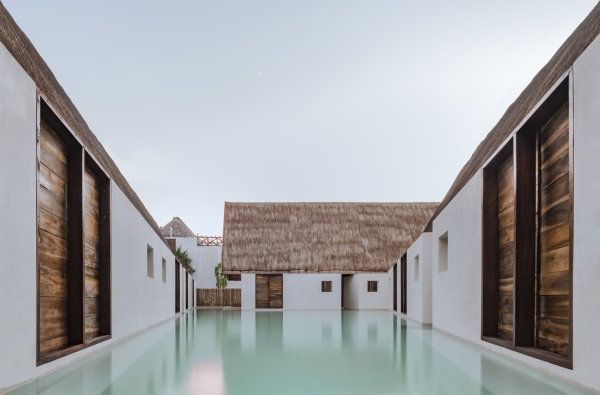In the history of architecture the concept of beauty has always been linked to different factors that represent, mainly, the values of society in a given period. The zeitgeist is certainly crucial to these definitions, so something that was once considered beautiful in the past is likely to be given another connotation nowadays. In this sense, aesthetic preferences in architecture seem to be linked to symbolic references implicit in the construction itself and in its relation with the world. They are preferences that express convictions, ideologies and positions, as well as moral, religious, political feelings and, of course, class status symbols.
For some time now, most wealthy architectures have been expressing their ideology through imported materials, flashy coatings, exuberant techniques and exquisite details. However, it is possible to perceive a paradigm shift with regard to the definition of luxury in the last few years.
The concern with sustainability and the future of the planet has become a key point in all human activities, and architecture is not exempt. Nowadays, realizing the vulnerability of natural resources and the imminence of irreversible climate change has become a luxury. Today, luxury is being able to cycle to work, living in the city without polluting the environment, having a large garden and harvesting your own vegetables, building a house with minimal impact on the natural environment, with low carbon emissions and using local materials and labor. This appreciation of sustainability is so latent that large high-end enterprises use it as a slogan for their marketing strategy — which does not always correspond to reality.
In this sense, construction elements and techniques that were previously related to limited budgets began to occupy another level, becoming not a mandatory choice, but a deliberate one. This restructuring of high-end aesthetics has been going on for some time with the incorporation of certain elements that in some contexts denote an ideology, while in others they may be a need.
Anyway, whether it is a genuine act or not, it is important to notice the incorporation of simple elements and even vernaculars in high-end buildings, modifying the conception of beauty and re-signifying the ideal of architecture.
Within these elements, rammed earth walls undoubtedly occupy a great place. Considered an economical, sustainable and low-impact solution, rammed earth has conquered high-end architecture through its numerous applications. In the Brazilian project of House in Mantiqueira, the rammed earth walls dialogue with symmetrical balances and a wooden structure. In the Mexican example of Earth House, the rammed earth walls were used with the intention of creating harmony between vernacular and contemporary architecture, as a bridge between the past and the present. Still in this language, Layer House also uses local earth in its walls built by native artisans, as does Vineyard House, in Portugal.
Thatch is another element that has been re-signified as an excellent example of a sustainable constructive solution, and yet efficient in terms of environmental comfort. Precisely for this reason, it has been conquering its space in high-end constructions. Punta Caliza Hotel in Mexico blends in with the green landscape using thatch as the predominant natural element, in the same way that Wabi House, derived from the Japanese term wabi sabi, suggests an aesthetic ideal that finds beauty in the imperfection, impermanence and depth of nature, translated above all by the natural thatch roof.
At Bamboo House, as the name implies, the main highlight is the panels made of this material, arranged in an unusual herringbone shape. Built for a couple who spend their lives sailing in the Mediterranean, this house combines concrete blocks and natural stone with bamboo. Whether applied as a covering, as in the braiding in the lining of Residência EA, or as a brise, as in the case of Casa Petro, bamboo has also assumed different roles that go beyond the usual scope and create new appropriations.
Last but not least, another popular material that has been incorporated into high-end buildings is cork. By its very nature, cork is recyclable and renewable, as the tree regenerates its own bark. Without suffering from the harvesting process, cork presents itself as a visually powerful and environmentally sustainable option for architectural projects. Used in the 2012 Serpentine Gallery Pavilion, designed by Herzog & de Meuron and Ai Weiwei, cork has taken on different uses and shapes, as seen at Bonjardim House, Villa Extramuros, or NH House.
________________________________________________________________________________________________________________________________________________________
▪ Source: Archdaily|https://www.archdaily.com/982723/sustainability-the-new-aesthetic-order
▪ Written: Camilla Ghisleni | Translated: Diogo Simões
▪ Images Credit:
01/ Punta Caliza Hotel Holbox / ESTUDIO MACIAS PEREDO. © César Béjar
02/ Casa Petro / Fernanda Padula Arquitetura. © Carolina Mossin
03/ House in Mantiqueira / Gui Paoliello Arquiteto. © Manuel Sá
04/ Wabi House / Tadao Ando Architect and Associates. © Shannon McGrath
05/ Wabi House / Tadao Ando Architect and Associates. © Edmund Sumner
06/ Bamboo House / Vilela Florez. © Maira Acayaba
07/ Residência EA / Solange Cálio Arquitetos. © Denilson Machado – MCA Estúdio
08/ NH House / Marc Rifà-Rovira. © Jaume Prat


